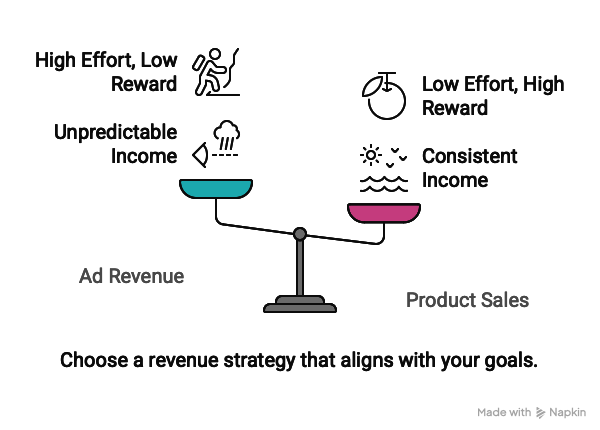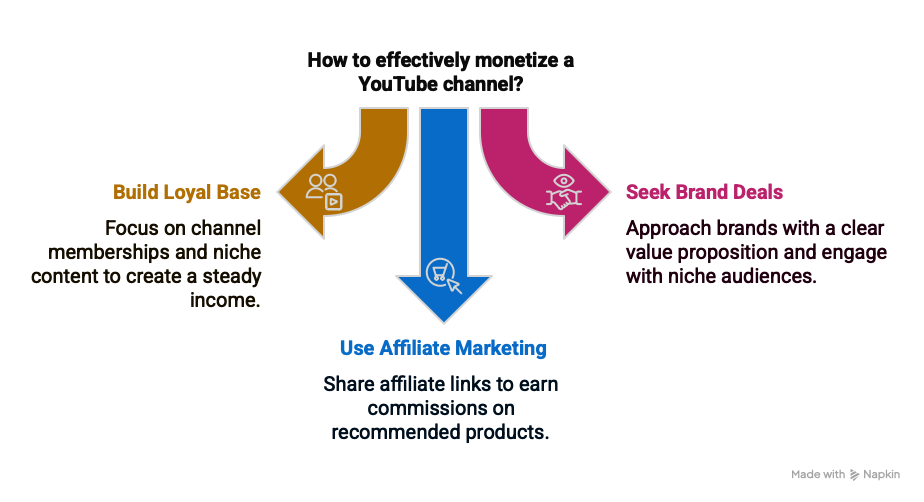Making Money on YouTube: Truth Behind the Myths
Apr 16
/
Joshua Botello
Empty space, drag to resize
So you’ve been pouring time into your YouTube channel—filming, editing, posting, tweaking thumbnails, maybe even obsessing over analytics. But the revenue? Not exactly what you expected. Maybe you’re wondering: Is it even possible to make real money on YouTube without going viral? Yes. But it requires shifting how you think about monetization.
If you’ve been relying solely on ad revenue or holding out for your first brand deal, you’re probably stuck in one of the five most common YouTube monetization myths. These myths don’t just waste your time—they can stunt your growth and keep you from building a sustainable business. In this post, we’ll bust five of the most common YouTube monetization myths and show you what really works to build a profitable, long-term channel.
Myth #1: Ad Revenue Is the Only Path to YouTube Wealth
YouTube’s Partner Program can feel like a major milestone—and it is. Once you're in the YouTube Partner Program, you’ll earn ad revenue—but YouTube takes a cut. And ads don’t always pay that much unless your videos go viral. But relying on ads alone? That’s like depending on tips to pay your rent. It’s unpredictable, and unless your views are massive, the payouts are modest at best.
Let’s talk
real numbers: the average YouTube CPM (cost per thousand views) ranges between $2–$5, depending on your niche. That means a video with 10,000 views might earn you $20–$50. Not exactly life-changing, right?
Now compare that to selling your own product. A digital planner, mini-course, or membership that sells for $27? You only need a few sales per video to outperform ad revenue.
Example Calculation: A video receives 100,000 views. Assume 60% are monetized (60,000 views). If the CPM is $5:
Total Revenue =(1000 × 60,000) = 300
5
Thus, the creator earns $165 from ads on this video. That’s the shift—from consumer to creator-entrepreneur. Your channel isn’t just a content hub. It’s a sales engine. A smarter strategy? Sell your own stuff.
This could be:
• Digital products (eBooks, courses, templates)
• Physical merchandise (branded apparel, tools)
• Services (coaching, consulting, freelance packages)

Myth #2: You Need Millions of Views to Make Real Money
If you’ve ever thought, I’ll start making money once I hit 100K subscribers, you’re not alone. Sure, viral videos can rake in ad revenue—but chasing them can be like playing the lottery. But here’s the truth: high views don’t automatically mean high revenue.
Monetization isn’t just about volume—it’s about value. Focus on building a tight-knit community that supports you regularly. Channels with small but highly targeted audiences often earn more per viewer than viral creators. Why? Because niche content attracts the right kind of attention.
Let’s say you run a YouTube channel for freelance designers. Even with just 5,000 subscribers, creators can provide exclusive perks to paying subscribers through
channel memberships. Benefits might include loyalty badges, emojis, members-only content, or priority access to Q&A sessions.
So no, you don’t need to chase virality. You need to build trust with the right people. You set the price and the perks. Even a few hundred loyal members can create consistent monthly income that’s far more predictable than waiting for ad spikes.
Myth #3: Only Huge Influencers Can Land Brand Deals
Think sponsorships are reserved for creators with silver play buttons? Think again. Brands today aren’t just chasing big numbers—they’re chasing relevance. Micro-influencers (creators with 10K–50K subscribers) often have higher engagement rates than large creators. And brands are taking notice.
If you’ve built a niche channel with an engaged audience, you’re already valuable. You don’t need a million views—you need a media kit, a clear value proposition, and the confidence to reach out.
Start with brands you already use. If you’re a fitness creator who swears by a specific protein powder, pitch them. Explain your audience, your reach, and why a partnership would be mutually beneficial. You can also join creator networks like YouTube BrandConnect, Famebit, or Shopify Collabs.

Myth #4: Your Earnings Are Limited to What YouTube Pays You
This might be the biggest myth of all: thinking YouTube alone will provide everything you need to monetize. YouTube is your stage—but your business needs multiple income pillars. And one of the most powerful? Affiliate marketing.
If you’re not using affiliate links, you’re leaving money on the table. If you’re already recommending tools, books, gear, or platforms in your videos, affiliate links are a no-brainer. You earn a commission every time someone buys through your link—no extra cost to your audience.
With affiliate marketing, you earn a commission when your viewers buy products through links you share. Let’s say you review productivity apps. Link to them through affiliate programs like
Impact,
ShareASale, or
Amazon Associates. With every click and conversion, you’re building passive income that doesn’t depend on view counts.
Just make sure your recommendations are honest and helpful. That’s how you maintain trust—and that’s how you keep people coming back.
Final Thoughts
If you’re serious about building a sustainable income from your channel, it’s time to let go of outdated assumptions. Making money on YouTube isn’t just about luck, viral fame, or ad dollars. It’s about strategy, connection, and knowing how to diversify your income streams.
You don’t need viral videos. You don’t need 100,000 subscribers. And you definitely don’t need to rely on AdSense alone. What you do need is a smart YouTube monetization strategy that fits your content, your audience, and your strengths.
By sidestepping these common myths and using proven monetization strategies, you’ll build a more sustainable channel—and a business you can actually live off.
Empty space, drag to resize
Funded in part through a Cooperative Agreement with the U.S. Small Business Administration. All opinions, conclusions, and/or recommendations expressed herein are those of the author(s) and do not necessarily reflect the views of the SBA.



